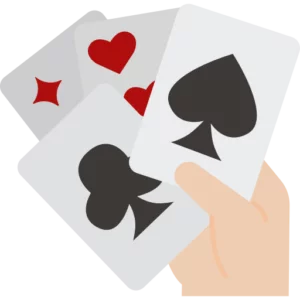Glossary Term
Over Card
Over Card
Used In: Poker
Introduction
In poker, the term overcard refers to a community or unseen card that holds a higher rank than any of the player’s hole cards. For example, if a player holds a Ten and a Seven, any card on the board ranked Jack or above is considered an overcard. These cards are significant because they have the potential to improve an opponent’s hand or challenge the current best hand, influencing betting strategies and decisions throughout a hand.
The presence of overcards on the board introduces a layer of uncertainty and risk for players. When overcards appear, players holding lower-ranked hole cards must consider the possibility that opponents may have connected with these higher cards, thus strengthening their hands. This dynamic forces players to evaluate not only their own holdings but also the range of potential hands their opponents might hold, often leading to more cautious or aggressive play depending on the situation.
Strategically, understanding overcards is crucial for effective decision-making in poker. Skilled players assess the likelihood of opponents holding overcards based on betting patterns, position, and previous actions. This awareness can dictate whether to continue in a hand, fold, or apply pressure through raises. Ultimately, recognizing the role and impact of overcards enhances a player’s ability to navigate complex board textures and improve overall gameplay.
In Depth Look
An overcard is a critical concept in poker because it directly impacts the relative strength of a player’s hand in relation to the community cards. Overcards are those community cards that rank higher than any of the player’s hole cards, potentially allowing opponents to form better pairs or stronger combinations. For example, if a player holds 8♠ and 9♣, and the flop reveals K♦, 7♣, and 2♠, the King is an overcard to the player’s highest card, the Nine. The presence of this higher card on the board creates a situation where opponents holding a King or better can claim a superior hand, significantly altering the player’s chances of winning that pot.
The strategic importance of overcards lies in their ability to influence betting patterns and psychological pressure during the hand. When overcards appear on the flop or turn, players must carefully evaluate how these cards affect both their own hand and the potential holdings of opponents. If the board contains multiple overcards, it increases the probability that at least one opponent has connected with a higher card, prompting more conservative play or cautious aggression. Conversely, if a player suspects opponents do not hold those overcards, the player might leverage the situation by betting or raising to represent a stronger hand, using the overcards as a bluffing tool.
From a probability and game theory perspective, overcards add complexity to decision-making by expanding the range of possible hands opponents might have. This complexity forces players to incorporate factors such as position, betting history, and opponent tendencies when estimating the likelihood that an overcard has improved someone else’s hand. Skilled players weigh these elements to decide whether to fold, call, or raise, balancing risk with potential reward. Understanding overcards thoroughly enables players to interpret board textures more accurately, make informed strategic choices, and ultimately improve long-term results in poker.
Mechanics
overcards function as cards on the board that rank higher than any of a player’s hole cards, affecting hand strength and potential outcomes. When an overcard appears, it introduces new possibilities for opponents who may hold cards matching or surpassing the board’s ranks. For instance, if a player’s highest hole card is a Nine and the board reveals a Queen, that Queen is an overcard to the player’s hand. This dynamic can shift the perceived strength of hands, as opponents might improve by pairing with the overcard or using it as part of a stronger combination.
Mechanically, overcards influence betting and decision-making by increasing uncertainty. Players must factor in how the presence of overcards alters the likelihood that an opponent has improved their hand. This requires constant assessment of board texture, betting behavior, and positional play. Overcards can also serve as bluffing opportunities, where players without a strong hand may represent having connected with these higher cards to force folds. Understanding these mechanics allows players to better gauge risk and adapt their strategies accordingly.
Key points:
- Overcards are community cards that rank higher than a player’s hole cards and can potentially improve opponents’ hands.
- Their presence changes hand strength evaluations and increases uncertainty in decision-making.
- Overcards can be used strategically for bluffing or applying pressure during betting rounds.


Illustrated Example
In poker, overcards refer to community cards that are higher in rank than any of the hole cards held by a player. For instance, consider a player holding 9♦ and 7♠. If the flop reveals Q♣, 5♠, and 2♦, the Queen is an overcard relative to the player’s highest card, the 9♦. This means the player does not currently hold a pair or higher-ranking card than the Queen on the board. As a result, opponents holding a Queen or better automatically have a stronger hand, which the player must consider when deciding how to proceed.
To illustrate this further, imagine another player holds K♠ and J♣ on the same board. For this player, the Queen on the flop is not an overcard since the King in their hand ranks higher. Therefore, the King-high hand is currently stronger than the first player’s Nine-high hand. Understanding overcards helps players assess how likely it is that an opponent’s hand has improved, influencing betting strategies, bluffing potential, and decisions on folding or continuing in the hand.
| Player Hole Cards | Board Cards | Highest Hole Card | Overcard(s) on Board? | Example Explanation |
|---|---|---|---|---|
| 9♦, 7♠ | Q♣, 5♠, 2♦ | 9♦ | Yes (Q♣) | The Queen on the board is higher than the player’s highest card (9), so it is an overcard. |
| K♠, J♣ | Q♣, 5♠, 2♦ | K♠ | No | The highest hole card (King) outranks the Queen on the board, so no overcard exists. |
Player Perspective
From a player’s perspective, overcards represent both a potential threat and an opportunity during a hand. When overcards appear on the board, a player holding lower-ranked hole cards must reassess the strength of their hand, as these higher cards increase the likelihood that an opponent has connected with the board to form a stronger pair or combination. This awareness often leads players to exercise caution, potentially folding weaker hands or slowing their betting to avoid costly mistakes. Conversely, recognizing when opponents are likely concerned about overcards can allow a player to exploit their hesitation through well-timed bluffs or aggressive plays.
Players also use overcards to interpret betting patterns and gauge the range of their opponents’ hands. For example, if overcards appear on the flop but opponents show weakness through checking or calling instead of raising, it may indicate they do not hold those overcards or strong hands connected to them. Conversely, aggressive betting following the appearance of overcards can signal that an opponent has made a strong pair or better. By carefully analyzing the presence of overcards and associated betting behavior, players improve their ability to make informed decisions, balance risk, and maximize potential winnings.
Conclusion
Understanding the concept of overcards is essential for effective poker strategy, as these higher-ranking community cards can significantly alter hand strengths and influence the flow of a game. Overcards introduce uncertainty by increasing the possibility that opponents have improved their hands, requiring players to carefully evaluate their position, betting patterns, and risk tolerance. Mastery of overcard dynamics enables players to make more informed decisions, optimize their betting strategies, and better anticipate opponents’ moves, ultimately improving their overall performance at the table.
The Top Online Casinos for Playing Poker
These platforms prioritize player satisfaction by providing intuitive interfaces, seamless gameplay experiences, and robust security measures to ensure a fair and enjoyable environment for all users.
welcome bonus
Welcome package €1,500 + 350 Free Spins
35x wagering (Deposit & Bonus)
Top 5 best casinos
$titl$ is not the Best Choice. Here are some better options:


Author
Branimir Ivanov | Senior News Contributor







